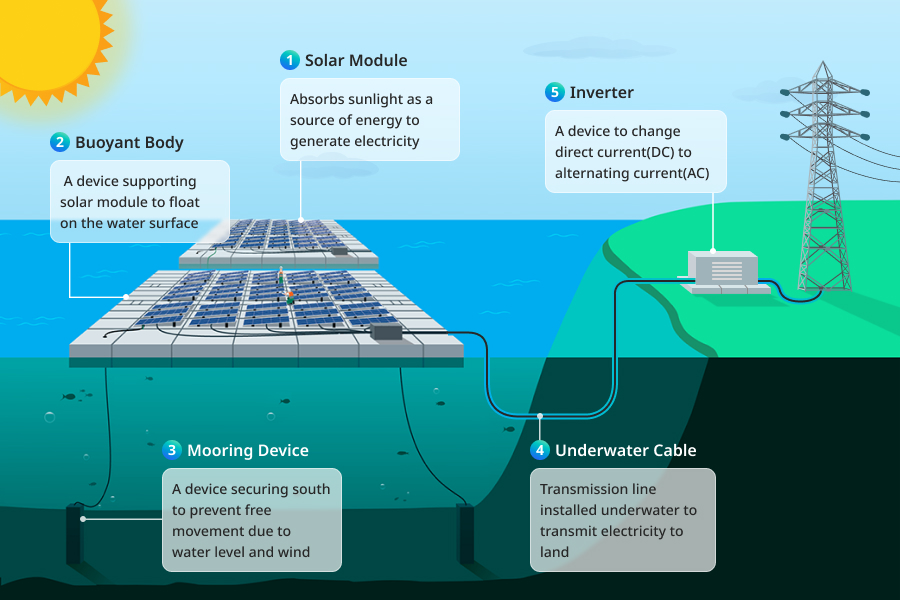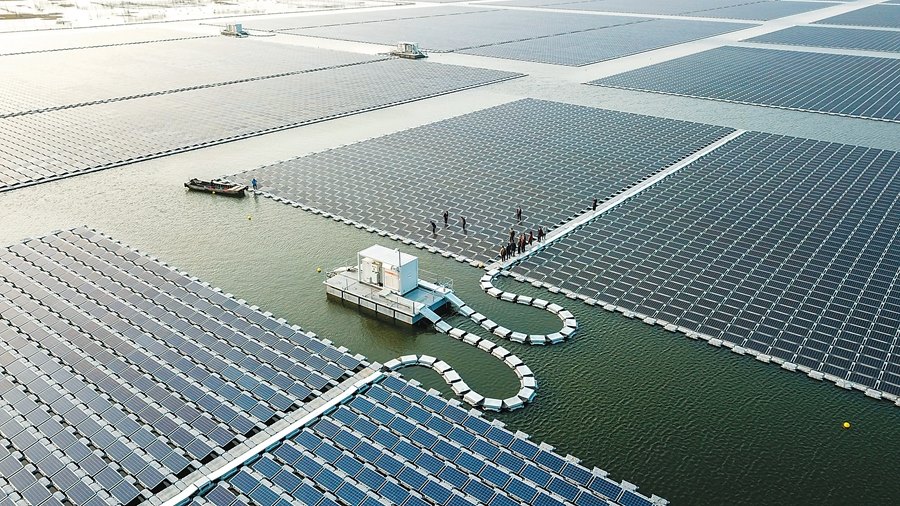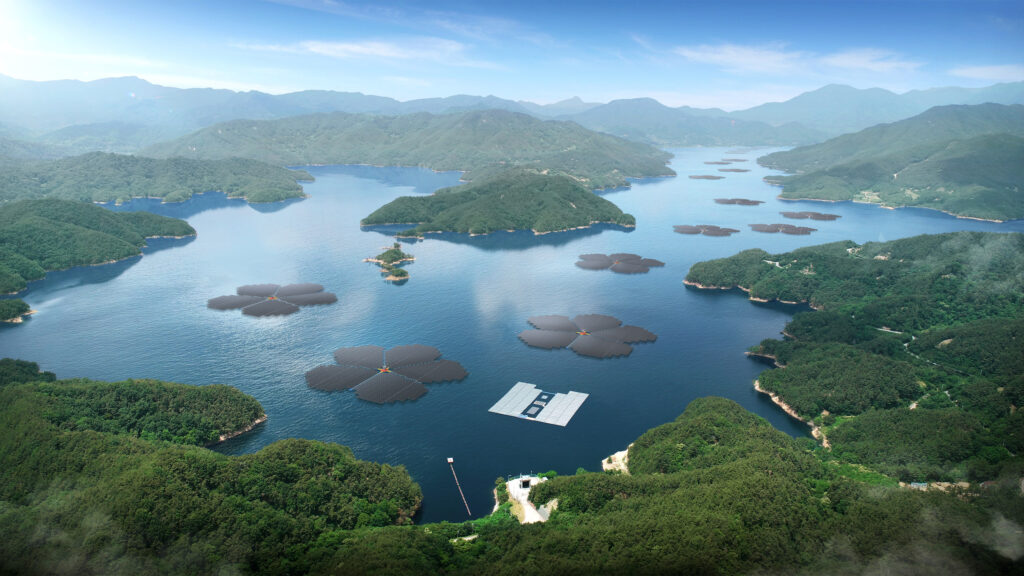- Floating solar power generation is a new area of opportunity that is booming globally.
- Floating solar power generation is 10% more efficient than inland solar power generation.
- It’s time to dispel some of the myths about floating solar power generation.
Solar panels are typically installed on the surface of the ground. There are a few challenges when it comes to installing solar panels on the ground, with the most common one being the difficulty of obtaining a suitable installation site. Land usually has an owner, so purchasing or leasing a piece of land entails a substantial cost. A prospective site for solar panel installation may need earthwork, which can be an environmental hazard. So how about installing solar panels on water? For one thing, waters do not have owners, and this factor alone enables a significant cost saving. Another pro is that over 80% of our planet’s surface is made up of water. This means we have almost an infinite supply of sites for solar panel installations.
The World Bank Group’s 2019 publication “Where Sun Meets Water: Floating Solar Market Report” indicates that installing floating solar technologies on just 1% of the surface of the entire world’s reservoirs could produce 521 TWh of electricity every year. This is a huge volume, amounting to 16% of the 3,446 TWh of electricity consumed by all of Europe in 2019, an eye-opening potential that prompted the World Bank Group to predict that floating solar technologies will make up the axis of solar technology advancement, along with inland solar technologies and structural solar technologies. The prominent market research company Grand View Research quantified a projected increase in US domestic demand for floating solar technologies to 4,690 MW by 2027, at a compound annual growth rate of 28.9%.
Why floating solar technology?
What makes the future of floating solar energy so promising? Here’s the answer. Because floating solar panels aren’t impeded in their reception of solar rays by the shadows of adjacent structures, and the water they float on provides a cooling function, floating solar panels produce 10% more electricity than inland solar panels. An added bonus with floating solar panels is that they improve water quality, because by blocking direct sunlight they suppress the growth of algae.
Drawn to these merits, a number of countries are initiating floating solar technology measures. The US state of Massachusetts has created an incentive program that provides a subsidy for floating solar panel installation based on energy production capacity, while Taiwan has adopted a feed-in tariff* policy that favors floating solar technologies over inland solar technologies. China is one of the world leaders in floating solar technology. In its province of Anhui there are over 166,000 solar power panels installed that produce 40 MW of energy, enough for 15,000 households.
The Netherlands is also embracing floating solar technology. With inland waterways that have a total area of 7,650 km², it stands to reap a great benefit from floating solar technologies. In 2018, it installed a large floating solar power plant in a reservoir located in the area of Lingewaard. In this development, 6,100 units of a Hanwha Q Cells 300 W photovoltaic module (Q.PEAK) were installed on water spanning 15,800 m² to produce over 1,800 MW of electricity each year, which is enough to meet the energy needs of 400 4-person households.
* Feed-in tariff (FIT): A feed-in tariff is an incentive system designed to provide long-term contracts to renewable energy producers. In Taiwan, a feed-in tariff rate of 4.772 NT$/kWh is applied to floating solar technologies, as opposed to the 4,379 NT$/kWh applied to inland solar technologies.
The most advanced floating solar technology

The typical floating solar system is structurally simple, consisting of an anchor, a buoy, and a photovoltaic module atop the buoy producing electricity. But despite this simple configuration, a floating solar system requires advanced technology to function while safeguarded from winds and waves.
Hanwha Q Cells, the world’s largest manufacturer of photovoltaic modules, is building what will be the world’s biggest floating solar power plant at Hapcheon Dam in Korea. Once complete, it will produce enough electricity to supply 60,000 users each year. Hanhwa Q Cells has been involved in the installation of floating solar power plants in a number of countries. Its floating photovoltaic module “Q.PEAK DUO Poseidon” is constructed from eco-friendly materials with advanced humidity resistance, and is ideal for hot, humid environments. The Q.PEAK DUO Poseidon is also highly salinity-resistant, as tests have verified its top performance in sea environments. In addition to being placed in charge of the Hapcheon Dam project, Hanhwa Q Cells has also been selected to install a 63MW floating photovoltaic system in Lake Goheung in Korea’s Southern Jeolla Province, which on completion is expected to meet the household energy demand of 90,000 users per year. This project pushed Hanhwa Q Cells’ cumulative sales of the Q.PEAK DUO Poseidon to the 100 MW mark.
Misconceptions about floating solar technology
In spite of its value, many are still skeptical when it comes to floating solar generation systems, mostly due to the potential for environmental hazards. As it happens, the Korea Environment Institute of the Ministry of Environment of Korea conducted an 8-year observation (2011-2019), divided into 4 phases, of the floating photovoltaic modules installed at Hapcheon Dam, and the data collected provides credible evidence of the environmental safety of floating solar generation systems. Let’s address some of the harmful myths related to floating solar generation systems.
1. Floating solar technologies pollute water.
The perception that thousands of floating solar panels, artificial devices, could be a threat to a natural water environment is totally understandable but is unsubstantiated. The Korea Environment Institute carried out an eight-year-long systematic monitoring of Lake Hapcheon in Korea. Comparisons of the water quality in locations of floating solar panel installation and in reference locations showed no significant differences. The belief that floating solar panels cause water pollution is false.
2. Floating solar panels cause the growth of algae.
While some research findings have indicated that floating solar panels accelerate the growth of algae, these were obtained in an artificial environment set up for testing. The Korea Environment Institute’s tests performed in the natural environment of Lake Hapcheon found no significant difference in plankton communities in locations of floating solar panel installation and in reference locations. If anything, fish of a range of species were found under the panels, some of them protected species.
3. No detection of heavy metals from floating solar panels
Comparisons of the sediments in Lake Hapcheon in locations where floating solar panels were installed and in reference locations found no notable difference. Floating solar panels are made of eco-friendly materials, and don’t emit harmful heavy metals.
4. The prolonged presence of floating solar panels produces harmful substances.
The Korea Environment Institute carried out water quality testing in Lake Hapcheon to a standard that demands a water quality more than 10 times better than that of potable water, and found no presence of harmful substances. Certain testing categories actually returned better results than expected. Rest assured, floating solar panels do not cause water pollution.

Release Date: Mar 01 2021
Caption:
China is a world leader in floating solar power. The image shows the floating solar power plant in Lake Chao, Anhui Province. Source: Anhui, China-gov Facebook
Connected Article: The Future of Floating Solar Power Generation
File Size: 184.56 KB

Release Date: Mar 01 2021
Caption:
The Netherlands’ natural environment is ideal for floating solar energy. The image shows the floating solar power plant in Lingewaard, which is in the central Netherlands. Source: Lingewaard Floating Solar Park website
Connected Article: The Future of Floating Solar Power Generation
File Size: 507.58 KB

Release Date: Mar 01 2021
Caption:
The above is a representation of the process of an anchored floating photovoltaic system’s operation. The basic mechanism is simple, but advanced technology is required. Concept View of Hapcheon Dam Floating PV Plant
Connected Article: The Future of Floating Solar Power Generation
File Size: 1.53 MB





 USA & Canada
USA & Canada Korea
Korea Germany
Germany United Kingdom
United Kingdom France
France Italy
Italy Netherlands
Netherlands Greece
Greece Poland
Poland Portugal
Portugal Hungary
Hungary Spain
Spain Australia
Australia Japan
Japan